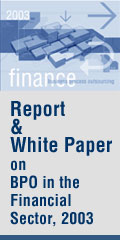|
|
Indian Banks: Impact of Basel II Implementation
07 August 2008: Fitch Ratings has commented that the renewed focus on risk brought by the Basel II guidelines has been timely, given the current credit environment that is turning increasingly challenging. The release of capital in a few of the business segments, including the regulatory retail portfolio, however, reduces the cushion available to banks to withstand the current downturn in the credit cycle, particularly in consumer loans.
In a special report entitled "Indian Banks: Impact of Basel II Implementation", Fitch discusses the business impact of the new Basel II guidelines on the capital ratios of the Indian banking system. The report highlights some of the modifications exercised by the Indian regulator (making comparisons to the document published by the Basel Committee on Banking Supervision), including the zero risk weights for direct exposures to both the central and state governments and higher risk weights on residential mortgage loans. "The use of national ratings for risk weighting corporate exposures could result in capital savings of about 100bp of the corporate loan portfolio of Indian banks, but makes it difficult to compare their capital adequacy ratios with banks in other countries," commented Ananda Bhoumik, Senior Director with Fitch's Financial Institutions team in Mumbai.
While most of the Indian banks that migrated to Basel II in FY08 reported a reduction in their total capital adequacy ratios (CARs) on account of a capital charge on operational risk (65-75bp), a few banks actually reported capital relief on account of higher exposures to better rated corporates or savings on the regulatory retail portfolio (including the small business segment). However, following the imposition of an additional charge for the unrated corporate portfolio that became applicable on 1 April 2008, Fitch believes that the sustainability of the capital relief remains to be seen, since the additional capital charge on account of the higher risk weight for unrated corporate loan portfolio could be up to 30-40bp.
In the report, Fitch also discusses how Basel II regulations may influence the proportion and direction of bank lending. This is because banks would find it increasingly attractive to give out loans to the small business segment that qualify as regulatory retail, given their higher lending margins and lower risk weights; although the agency notes that the small manufacturing segment has traditionally been most vulnerable to delinquencies during an economic slowdown. Also, the increase in risk weight for residential mortgage loans where the loan to value (LTV) exceeds 75% could dissuade aggressive lending policies by some banks.
In a recent guideline, the Reserve Bank of India has required banks to develop an Internal Capital Adequacy Assessment Process to address risks not captured under the first pillar (minimum capital requirement). While banks are integrating these into their risk management systems, the internal capital planning process appears to throw up the CAR threshold by about 200bp to 300bp higher than the regulatory minimum ratio of 9%. Additionally, Indian banks have also been working on internal risk models in preparation of the Internal Risk Based approach for credit risk, although it may take a few years before these are ready for validation.
After being postponed by a year to allow greater preparation, the standardised approach on credit risk and the basic indicator approach for operational risk were implemented on 31 March 2008 by Indian banks having international operations.
Banknet's Fourth International Bank Tech Summit, 2008 will discuss on issues related to Basel II preparedness of Indian Banks ...Click here
Basel II norms overlooked by NPA ridden banking sector
90% of Asian Banks Have Commenced Preparations for Pillar 2
Steps to strengthen the resilience of the banking system
Global credit quality worsens in first quarter 2008
Current challenges in the global financial markets
Highest levels of political and economic uncertainty in 2008
CLICK FOR MORE FEATURES & STORIES

|
|


|



